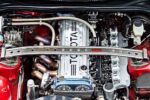Honda Turbo Engines: A Brief Overview
The Evolution of Honda’s Turbocharged Technology
Honda has long been recognized for its engineering prowess and innovation in the automotive industry. The company made a name for itself with reliable, fuel-efficient vehicles that appealed to a broad audience. However, the automotive landscape began to shift in the late 20th century as manufacturers sought to enhance performance while adhering to increasingly stringent emissions regulations. This led Honda to explore turbocharging as a viable solution.
Turbocharged engines offer a way to extract more power from smaller displacement engines, allowing for improved fuel efficiency without sacrificing performance. Honda’s foray into turbocharging began in earnest with the introduction of the 1.5-liter turbo engine in the 2016 Honda Civic. This marked a significant shift in Honda’s approach, as the company had previously focused on naturally aspirated engines. The turbocharged Civic quickly gained popularity, showcasing Honda’s ability to blend performance with practicality.
Despite the initial success of Honda’s turbo engines, they have not been without their issues. As the technology has evolved, various problems have surfaced, raising concerns among enthusiasts and everyday drivers alike. From oil consumption to turbo lag, these issues can detract from the overall driving experience and lead to costly repairs. Understanding these problems is crucial for anyone considering a Honda turbo engine, whether for performance upgrades or daily commuting.
In this article, we will delve into the common problems associated with Honda’s turbo engines, examining their implications and offering insights for current and prospective owners.
Common Problems with Honda Turbo Engines
Oil Consumption Issues
One of the most frequently reported problems with Honda turbo engines is excessive oil consumption. This can be attributed to several factors, including:
- Piston ring wear
- Turbocharger seal failure
- Improper oil viscosity
When oil is consumed at a higher rate than normal, it can lead to a range of issues, including reduced engine performance and potential engine damage if not addressed promptly.
Turbo Lag
Turbo lag is another common complaint among Honda turbo engine owners. This phenomenon occurs when there is a delay between pressing the accelerator and the turbocharger delivering power. Factors contributing to turbo lag include:
- Turbocharger size
- Engine tuning
- Exhaust flow restrictions
While some lag is expected in turbocharged engines, excessive lag can frustrate drivers and diminish the overall driving experience.
Overheating Problems
Overheating can be a significant concern for Honda turbo engines, particularly in models that push performance boundaries. Factors leading to overheating include:
- Insufficient cooling system capacity
- Faulty thermostat
- Coolant leaks
Overheating can lead to severe engine damage, making it crucial for owners to monitor engine temperatures and address any cooling issues immediately.
Fuel System Issues
Turbocharged engines often require a more sophisticated fuel delivery system to maintain optimal performance. Problems can arise from:
- Clogged fuel injectors
- Fuel pump failures
- Inadequate fuel pressure
These issues can lead to poor engine performance, reduced fuel efficiency, and increased emissions.
Table of Common Problems and Symptoms
| Problem | Symptoms | Consequences |
|---|---|---|
| Excessive Oil Consumption | Low oil levels, blue smoke from exhaust | Engine wear, potential engine failure |
| Turbo Lag | Delayed acceleration, sluggish response | Frustrating driving experience |
| Overheating | High temperature gauge, steam from engine | Severe engine damage, costly repairs |
| Fuel System Issues | Poor acceleration, rough idling | Reduced performance, increased emissions |
Conclusion
Understanding the common problems associated with Honda turbo engines is essential for both current owners and potential buyers. Awareness of these issues can help in early detection and prevention of more severe damage. Regular maintenance and monitoring can mitigate many of these problems, ensuring a more reliable and enjoyable driving experience.




0 Comments